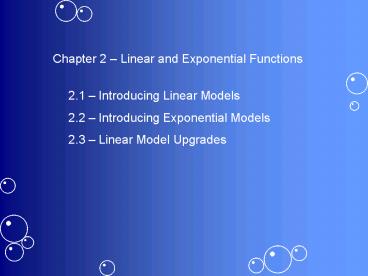Chapter 2 PowerPoint PPT Presentation
1 / 15
Title: Chapter 2
1
Chapter 2 Linear and Exponential Functions
2.1 Introducing Linear Models 2.2 Introducing
Exponential Models 2.3 Linear Model Upgrades
2
2.1
A linear function models any process that has a
constant rate of change. m
The graph of a linear function is a straight line.
A linear function has the form y f(x) b
mx where f is the name of the function. b is
the starting value or y intercept (f(0)). m is
the constant rate of change or slope.
slope intercept form
3
2.2
An exponential function models any process in
which function values change by a fixed ratio or
percentage.
An exponential function models any process in
which the ratio of consecutive function values is
constant.
The graph of an exponential function is curvy.
An exponential function has the form y f(x)
c ax where f is the name of the function. c
is the starting value or y intercept (f(0)). a
is the growth factor (ratio of consecutive
function values)
4
2.2
A mutual fund grows by 5 each year. What is the
growth factor?
t (years) 0 1 2
f () P P 0.05P (1.05)P (1.05)P.05(1.05)P (1.05)(1.05)P
ratio of consecutive output values ratio of consecutive output values
t f(t1)/f(t)
0 f(1) / f(0) (1.05)P / P 1.05
1 f(2) / f(1) (1.05)(1.05)P / (1.05)P 1.05
Growth factor is 1.05 100 5.
f(t) P(1.05)t
5
2.2
In 1992, U N Population Fund predicted this
decade will add a billion. In 1992, the world
population was 5.23 billion people and predicted
to increase by 91.25 million people that year.
linear model assume constant rate of change of
91.25 million people per year.
exponential model assume constant percentage
change 91.25/523 1.74
linear model W(t) 5230 91.25t where t is
years since 1992 and W is in millions of people
exponential model W(t) 5230(1.0174)t where t
is years since 1992 and W is in millions of
people
6
Exponential model almost matches prediction.
7
Depreciation of Jasons 3000 sound system
equipment
Method 1 Linear Model Depreciation by same
amount(300) for lifetime of equipment(10
years). B(t) 3000 300t
Method 2 Exponential Model Double Declining
Balance Depreciation double the percentage from
the linear method and apply each year. 300/3000
10, so value decreases by 20 each year.
V(t) 3000(.80)t
8
At what point do both models predict the same
value?
t 8.5
9
Exponential Models What if percentage and growth
factor are not explicitly stated? What if only
data points are given?
Example 29/84 A biology student counts 12
bacteria in a petri dish at the start of an
experiment and 34 bacteria three hours later.
Find the growth factor and write an exponential
model for the number of bacteria t hours from the
start of the experiment.
34 f(3) 12 a3
f(x) c ax
34 12 a3
f(x) 12 ax
34 / 12 a3
f(x) 12 (1.42)x
2.83 a3
(2.83)(1/3) a
1.42 a
growth factor is 1.42 42 growth per hour
10
More Practice
Check Your Understanding 2.4 (page 70)
Check Your Understanding 2.5 (page 71)
11
More Practice
12
Section 2.3Linear Model Upgrades What if
starting value is not explicitly stated? What if
rate of change is not explicitly stated?
Example The average girl in the US is 102 cm
tall at age 4. From then until age 13, her rate
of growth is nearly constant at 6.1 cm per year
f(4) 102 and m 6.1.
f(x) b mx
b is not given
BUT 4 input gives 102 output
f(x) 102 6.1(x-4) for 4 x 13
adjust for starting values!
13
Section 2.3Linear Model Upgrades What if
starting value is not explicitly stated? What if
rate of change is not explicitly stated?
Example 3/74 Write a formula for the linear
function that contains the points (4,-10) and
(-3,-12)
YIKES! no starting value and no slope.
Calculate slope m (-10 (-12)) / (4 (-3))
2/7
Adjust starting values f(x) -10 (2/7) (x
4) or f(x) -12 (2/7) (x 3)
14
- The Point-Slope Form of a Line
- Given any two points not in the same vertical
line, write a linear function in two steps - Calculate slope ( rise/run or ?y / ?x ). Call
it m. - Use one of the points (x1 , y1 ) as starting
and adjust using the template - f(x) y1 m( x x1)
More Practice Check your understanding 2.6 2
15
Chapter 2 Linear and Exponential Functions
HWp81 1-45 TURN IN 26(include Maple graph),
30, 41(include Maple graph and solve command),
44

